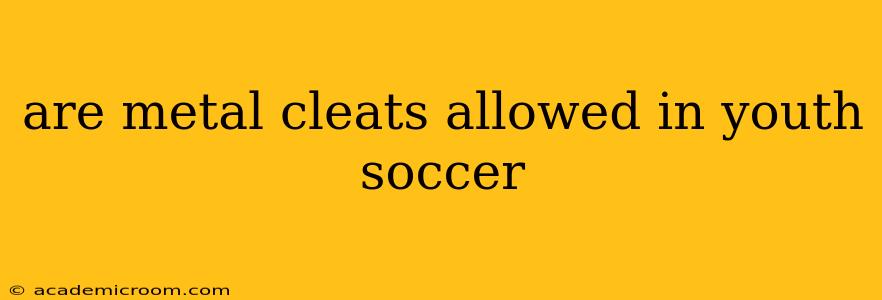The question of whether metal cleats are allowed in youth soccer is a common one, sparking debate among parents, coaches, and players alike. The answer, unfortunately, isn't a simple yes or no. It depends on several factors, including the specific league's rules, the age group of the players, and the type of field being used. This comprehensive guide will clarify the regulations and help you make informed decisions.
What are the different types of soccer cleats?
Before diving into the rules, it's crucial to understand the different types of soccer cleats. Cleats are broadly categorized based on their sole plate material:
- Metal Cleats: These feature metal studs, often providing superior grip on firm ground. However, their potential for causing injury is a major concern.
- Firm Ground (FG) Cleats: These typically have plastic or nylon studs and are suitable for dry, firm surfaces. Many FG cleats offer a balance of grip and safety.
- Soft Ground (SG) Cleats: Designed for softer surfaces like muddy fields, these cleats usually have longer metal studs or screw-in studs. This type is less common for younger players.
- Artificial Ground (AG) Cleats: These cleats have shorter, more numerous studs, ideal for artificial turf surfaces.
- Multi-Ground (MG) Cleats: These offer a combination of stud types to provide versatility across different surfaces.
Are metal cleats allowed in youth leagues? (A nuanced answer)
The short answer is: often, no, but it depends. Many youth soccer leagues, particularly those for younger age groups, explicitly prohibit metal cleats. This is primarily due to safety concerns. The risk of injury, both to the player wearing the cleats and their opponents, is significantly higher with metal cleats. A sharp metal stud can easily cause a serious injury during a tackle or collision.
However, some leagues might permit metal cleats for older youth players (e.g., those in the U15 or U16 age brackets) or under specific circumstances. Always consult your league's official rules and regulations. This information is usually available on the league's website or through your child's coach.
What do the rules say about different surfaces?
The type of field also influences the allowed cleat type. Metal cleats are generally more acceptable on firm, natural grass, but even then, many leagues still prohibit them for safety reasons. They are almost always forbidden on artificial turf, as the metal studs can damage the surface and increase the risk of injury.
Are metal cleats safe for youth soccer players?
No, metal cleats are generally considered less safe for youth soccer players than cleats with plastic or rubber studs. The increased risk of injury is the primary reason most leagues prohibit them.
What are the alternatives to metal cleats for youth players?
Firm ground (FG) cleats are the most common and safest alternative for youth soccer. These provide sufficient grip on most playing surfaces without posing the same injury risk as metal cleats. AG cleats are appropriate for artificial turf.
What are the consequences of wearing disallowed cleats?
The consequences of wearing metal cleats when they're prohibited vary from league to league. It could range from a warning to the player being ejected from the game, to the team facing a penalty. The specific penalty is usually outlined in the league's rules.
How do I find out my league’s rules on cleats?
The best way to find out is to check your league's official website, your child's team handbook, or contact your coach or league administrator directly. Don't rely on assumptions; clarity is crucial for safety and fair play.
By understanding the different cleat types and following your league's specific rules, you can ensure your child plays safely and complies with regulations. Remember, prioritizing safety is paramount in youth soccer.
